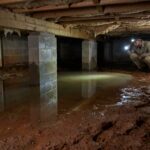Essential Guide to Effective Foundation Repair: Ensuring Long-Term Stability for Your Home
When it comes to homeownership, there’s a lot to think about. From choosing the perfect paint color for your living room to keeping your lawn neatly trimmed, the list goes on and on. However, one of the most critical yet often overlooked aspects of maintaining a home is its foundation. Think of your foundation as the unsung hero of your house—the sturdy base that keeps everything upright, safe, and sound. If your home’s foundation begins to falter, it can lead to a cascade of problems that might make you wish you had never picked up that paintbrush in the first place. So, let’s dive into the essential guide to effective foundation repair and ensure your home remains stable for years to come.
### Understanding Foundations: The Basics
Before we get into the nitty-gritty of foundation repair, let’s take a moment to appreciate what a foundation actually does. A foundation is essentially the lowest load-bearing part of your house, tasked with supporting everything above it. This encompasses walls, roofs, and even your beloved collection of ceramic frogs (you know who you are). Foundations can be made from various materials, including concrete, stone, and even brick.
There are generally two primary types of foundations:
1. **Basement Foundations**: These foundations include a basement space and are typically built using either poured concrete or concrete block.
2. **Slab Foundations**: This type is laid flat on the ground and is often used in warmer climates where freezing isn’t a concern.
Now that we have a foundational understanding (pun intended) let’s explore when and why you might need to consider foundation repair.
### Signs Your Foundation Needs Repair
Just like that nagging pain in your back after an ambitious gardening weekend, your foundation will give you signals if something’s amiss. Here are some warning signs you should not ignore:
– **Cracks in Walls**: If you’ve noticed cracks running along your walls, especially around windows and doors, it could indicate that your foundation is shifting or settling.
– **Uneven Floors**: Do you feel like you’re training for an Olympic event every time you walk across your living room? Sloping or uneven floors can be a sign of foundation issues.
– **Doors and Windows Stick**: If your doors and windows are playing hard to get, it might be because the frames are shifting due to foundation movement.
– **Gaps Between Walls and Ceilings**: If there are noticeable gaps between your walls and ceilings, it’s time to call in the professionals.
– **Moisture Issues**: Persistent leaks or standing water in your basement can also suggest that your foundation needs attention.
If you’re nodding along, it might be time to get a professional opinion—or at least give your foundation a stern talking to.
### Types of Foundation Problems
Foundations can run into a variety of issues, each with its own set of causes and solutions. Understanding these common problems can help you diagnose and address them more effectively.
1. **Settlement**: This occurs when the ground underneath your foundation settles unevenly, causing parts of the foundation to sink. It can result from poor compaction of soil, excessive moisture, or even the weight of the home itself.
2. **Heaving**: On the flip side, heaving happens when soil expands, pushing your foundation upwards. This can occur during freeze-thaw cycles or when clay soil absorbs too much moisture.
3. **Cracking**: Cracks can form in both the home’s interior and exterior walls, indicating stress on the structure. While some cracks are normal, wide or deep cracks signal a more serious issue.
4. **Water Damage**: Water intrusion is a common problem that can result in mold growth and structural damage. This often originates from poor drainage or inadequate waterproofing.
5. **Pests**: Yes, termites and other pests can weaken your foundation, albeit indirectly, by damaging structural wood. If you see signs of termite activity, it could compromise the foundational integrity.
### DIY vs. Professional Repairs
So, you’ve spotted some red flags. Now what? Should you grab your toolbox and become a DIY hero, or is this a job for the pros? Here’s a simple breakdown:
#### When to Go DIY:
– **Minor Repairs**: Small cracks and minor cosmetic issues might be manageable if you possess basic handyman skills.
– **Basic Maintenance**: Keeping gutters clear and ensuring proper drainage away from your foundation are tasks that can easily be tackled by a determined homeowner.
#### When to Call Professionals:
– **Major Structural Issues**: If you’re facing significant settlement or heaving, it’s best to leave it to the experts. Misdiagnosing these problems can lead to further damage.
– **Complex Repairs**: If the solution involves piers, underpinning, or extensive excavation, you’ll want to call in a professional with the right equipment and expertise.
– **Diagnosis**: Sometimes, it’s tough to determine the root cause of the problem. A foundation repair specialist can conduct a thorough evaluation to provide a tailored solution.
### The Foundation Repair Process
Ready to tackle those pesky foundation issues? Here’s a step-by-step guide on how the process typically unfolds:
1. **Inspection**: A qualified foundation expert conducts a comprehensive inspection of your property to assess the extent of damage. They will look for cracks, moisture levels, and signs of pest activity.
2. **Diagnosis**: Based on their findings, the professional will determine the underlying cause of the issues. This is crucial, as fixing the symptoms without addressing the source can lead to repeat problems.
3. **Repair Plan**: The contractor will develop a tailored repair plan that may include options like piering, underpinning, or wall anchors, depending on the specific issues found.
4. **Execution**: Once you agree on a plan, the repairs commence. Expect heavy machinery if major work is involved—let’s face it, your shovel just won’t cut it.
5. **Follow-Up**: After the repairs are completed, it’s wise to schedule follow-up inspections. This helps ensure that any new developments are caught early and addressed appropriately.
### Prevention Is the Best Medicine
After investing in foundation repairs, the last thing you want is for the same issue to pop up again. Preventative measures can save you time, money, and headaches down the line. Here are some tips to protect your foundation:
– **Proper Drainage**: Ensure your gutters and downspouts are working effectively and directing water away from the foundation.
– **Maintain Soil Moisture**: Don’t let the soil around your foundation dry out completely or become overly saturated. Regular watering and landscaping can help maintain a stable environment.
– **Regular Inspections**: Make it a habit to inspect your home annually for any signs of foundation issues.
– **Tree Placement**: Be mindful of the placement of trees and shrubs. Roots can undermine your foundation and change the soil’s moisture content.
### Conclusion
Your home is more than just a shelter; it’s a sanctuary—a fortress against the chaos of the outside world. To keep it standing strong, maintaining your foundation is non-negotiable. By understanding the signs of foundation issues, knowing when to go the DIY route or call in professionals, and taking proactive steps, you can ensure that your home remains stable for years to come.
So, keep an eye on those walls, cherish your solid floors, and treat your foundation like the unsung hero it is. Because in the grand saga of homeownership, nothing says “I care” quite like a sturdy, well-maintained foundation. Now that’s a story worth coming home to!


